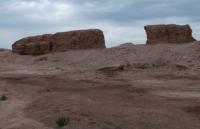You are here
Ancient cities of Dekhistan.

Sightseeing tours to Turkmenistan.
“From him (Merv) came the majority of the military leaders (qaid) of the Caliphate and officials (qatib) of him in Iraq, the rulers of Khorasan, as well as many outstanding lawyers and famous language experts. If in our book we did not adhere to certain boundaries and if that, the explanation of which we left, was not known from stories and books, we would have written about different classes of people and so on, which we mentioned briefly
“Kitam Mesalik Al-Memalik. Merv »Al-Istarhi.
Sightseeing guide Turkmenistan.
The ancient settlement of Dehistan is located at an altitude of 161 meters above sea level, located in the northern part of the Masrian plain and in the southern part of the Choganly plain, in the northwestern part of the Khurmen sands, 16.7 kilometers north-west of the village of Madau, 41.3 kilometers to the north-east from the small village of Indyrlan in the Etrek etrap of the Balkan velayat.
The Misrian Plain is one of the most unusual places on the territory of Turkmenistan. There was no intensive construction here, these lands are also of little use for agricultural work, therefore, many historical monuments have been preserved here.
The earliest traces of human activity on these once fertile lands date back to the middle of the 2nd millennium BC. At that time, there were the largest settlements of ancient civilizations - Madau-Depe, Izzatkuli and Tangsykylja, and there was the most powerful irrigation system in all of Central Asia.
This historical area, commonly known as Hyrcania, flourished under the Achaemenids, during the Parthian era, under the Sassanids, and reached its peak during the Islamic period. The ruins of the once brilliant cities of Djurdjan and Dehistan have survived to this day, but scientists believe that the sands of the desert hide many more unknowns.
Dekhistan is considered the most important medieval oasis in the southwestern part of Turkmenistan. On these lands from the 8th to the 14th century there was the city of Misrian, which reached its highest power during the period of the Khorezmshahs.
The total area of the city was about 200 hectares, and it was protected by a double ring of walls. Numerous ruins of various structures that have survived to this day testify to its former greatness. Like most cities of that era, Dekhistan was divided into a well-fortified "shahristan" with a citadel and a "rabat".
Only the famous Shir-Kabir mausoleum, two minarets 25 meters high, the portal of the cathedral mosque, the remains of the muddy clay city walls, the ruins of caravanserais and mausoleums at the Mashad necropolis have survived.
Several caravanserais, located around the settlement behind the fortress wall, mark the location of several city gates, indicating the direction of the caravan routes from the city. Today the city is almost destroyed, and most of its structures are covered with desert sands, however, due to the fact that it was here that the famous poem by Ferdowsi "Shahnameh" was written, the city is of great historical and cultural value, and excavations on its territory will continue.
A large trade caravan route from Khorezm to Hyrkania, located in Northern Iran, in the lower reaches of the Gorgan River, ran through Dakhistan.
Geographic coordinates of the settlement of Dehistan: N38 ° 15'04.35 "E54 ° 36'53.46"
Authority:
"Ancient and new roads of Turkmenistan". V.S. Zaletaev. 2009.
http://etnolingvistika.ru







